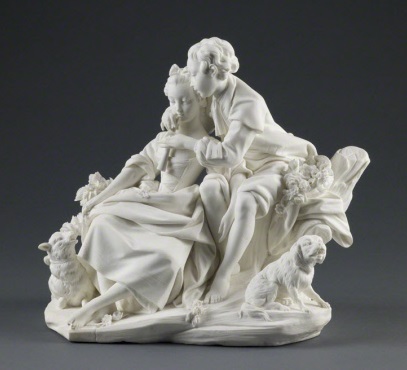Porcelain Factory of Sèvres, The Flute Lesson, 1757-66

The Work
This porcelain figure shows a young couple taking advantage of a music lesson in order to embrace. The young woman is leaning back against the young man’s shoulder, and his arms are around her neck under the pretext of showing her how to play the flute. The small sheep suggests that she is a shepherdess. In an amusing detail, on the boy's left, a little dog is barking.
Historical Moment
The technique of making ceramics, already known in China, was further developed in 18th- century Europe. This allowed artists to create very delicate works. Each piece had to be fired in the kiln several times, at very high temperatures (2,012º F), and therefore could break easily. A ceramic sculpture as detailed as this one was considered rare and valuable.
The Genre
In the artistic style known as "fête galante," young couples in love are shown relaxing in the outdoors. The characters are often imaginary peasants, such as shepherds and shepherdesses, but they resemble nobles in the elegance of their bodies, gestures, clothing, and hairstyles. Fine porcelain sculpture imitated characters and situations from the "fêtes galantes," as well as characters from the popular theater of the time. When porcelain is not painted, it resembles stone sculptures from antiquity, which makes it appear even more "noble," even if its subject is contemporary.
The Artist
The porcelain factory in Sèvres was founded in 1756, by the order of Louis XV and Madame de Pompadour. It was intended to rival the famous factory of Meissen in Germany. The Sèvres artists were men, and the one who created this work is unknown, but François Boucher made designs for many Sèvres porcelain figures.

